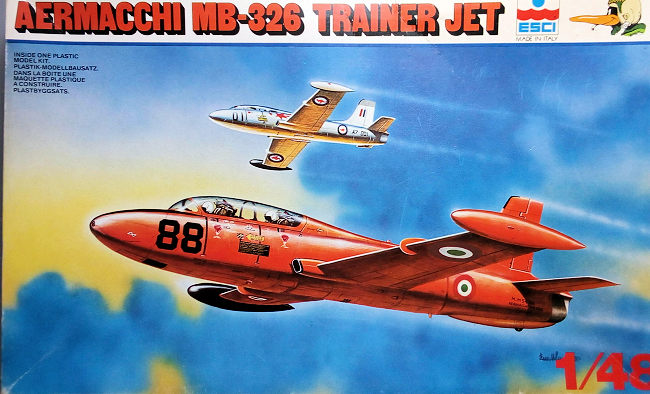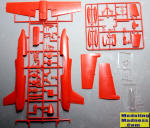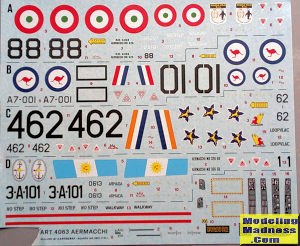
| KIT #: | 4063 |
| PRICE: | €20.00 |
| DECALS: | Four options |
| REVIEWER: | Spiros Pendedekas |
| NOTES: |

| HISTORY |
The Aermacchi MB-326 was
a low-wing monoplane with an all-metal structure composed of light alloys. As
originally developed, the MB-326 functioned as a refined but simple aircraft
capable of covering the considerably wide range of performance characteristics
required on both ab initio training and advanced instruction alike; other major
characteristics of the type included the capacity to deliver a high rate of
utilization in conjunction with minimized servicing and maintenance
requirements. A high degree of safety was also intentionally built into it,
including the adoption of Martin-Baker ejection seats.
The MB-326 was powered by a single Rolls-Royce Viper non-afterburning turbojet
engine, which possessed multiple favorable attributes in par with the MB-326’s
philosiophy of simplicity and robustness, with a somewhat forgiving nature to
mishandling in the air by students. Accordingly, the MB-326 was readily capable
of performing relatively slow speed take-off and landing while retaining an
excellent rate of climb.
The MB-326 was outfitted with a tandem cockpit configuration, this arrangement
had been chosen to result in a slimmer and more aerodynamically efficient
fuselage in comparison to the then more usual side-by-side arrangement. A bubble
canopy offered excellent visibility.
Though originally conceived as a two-seat trainer, there have also been single
and two-seat light attack versions produced. It is one of the most commercially
successful aircraft of its type, being bought by more than 10 countries and
produced under license in Australia, Brazil and South Africa. It set many
category records, including an altitude record of 56,807 ft. More than 800
MB-326s were constructed between 1961 and 1975.
| THE KIT |
 ESCI
first released this kit back in 1981 as the single seater MB-326K Impala,
followed by the double seater version in 1982, with both versions periodically
reissued ever since (mostly the trainer version), the latest ones by Italeri. My
kit was the 1982 initial release double seater version. It came in the classic
top opening Esci box of those times, featuring an attractive boxart of an
Italian and an Australian MB-326 flying in some kind of formation.
ESCI
first released this kit back in 1981 as the single seater MB-326K Impala,
followed by the double seater version in 1982, with both versions periodically
reissued ever since (mostly the trainer version), the latest ones by Italeri. My
kit was the 1982 initial release double seater version. It came in the classic
top opening Esci box of those times, featuring an attractive boxart of an
Italian and an Australian MB-326 flying in some kind of formation.
Upon opening the box, which is too big for the kit contents, I was greeted with
two sprues of red styrene sealed together (with a couple of parts broken off)
and two small clear frets sealed in separate bags. Detail is nicely engraved and
molding is relatively crisp (expected from it being the initial release), with a
hint of flash at some “detail” parts and a couple of ejector pin marks at places
you would not want them to be (i.e. tires or doors innards).
Cockpit is barely average, with two good looking seats, sticks and flat instrument panels. The (also flat) side consoles are molded onto the cockpit tub. All instruments are represented by decals, a typical feature of ESCI kits back then. Landing gear legs and wheels are good looking (with the exception of the above mentioned nasty pin marks on tires sidewalls and doors innards). Wheel well detail is basic at the mains and totally flat at the nose one.
There is some kind of relatively deep intake
ducting that ends nowhere (you might consider to somehow blank it and paint its
end flat black, but it does not look too easy...). The exhaust is shallow and
tad simplistic, again, an ESCI trend back then. Clear parts are well molded,
relatively thin and crystal clear, no remarks here!
Instructions are typical ESCI of the times, provided in the form of a big
pamphlet, with the construction spread in 8 clear steps. Color callouts are
provided for most areas during construction (not provided for intake innards),
but you can very easily download the same kit’s newer, better and complete
Italeri ones from the amazing Scalemates site.
 Four very
interesting schemes are provided, an all-red Italian, a silver Australian
aerobatic, an also silver South African and a gray over white Argentinian.
Decals are beautifully done by Cartograf and include a good number of
maintenance stencils; though old, they seem in very good condition.
Four very
interesting schemes are provided, an all-red Italian, a silver Australian
aerobatic, an also silver South African and a gray over white Argentinian.
Decals are beautifully done by Cartograf and include a good number of
maintenance stencils; though old, they seem in very good condition.
Instructions first want you to assemble the cockpit and install the seats, then
assemble the wing by attaching the two upper halves onto the one-piece lower
half. Next the fuselage halves are joined with the cockpit and the exhaust
trapped in between, followed by attachment of the main wing, tail planes, wing
tanks and lower intake walls. Then is attachment of canopy and front compartment
cover (both optionally at “open” or “closed” positions) and finally landing gear
installation
| CONCLUSIONS |
If you want a quarter scale MB-326, this is still (2021) the only game
in town. Though getting elderly this is still an acceptable kit of this
important plane, with seemingly correct shape and nice engraved panel lines. Fit
is expected to be good, with some dry-fitting proving so. Decals are good and
the same can be said for the instructions (you can nevertheless download the
excellent recent Italeri ones).
On the minus side, cockpit detail (a key area in trainers) is average, the same
being true for more or less the rest of the detailing. I was pleasantly
surprised to see that quite a bit of beautiful aftermarket stuff seems to exist
for this kit, practically addressing the majority of the kit’s shortcomings,
with the usual “concerns” of availability, price and, of course fit, so you
should perform your quality research here!
The kit is reissued by Italeri from time to time, with excellent instructions
and decals. The kit’s low parts count and seemingly ease of construction deem it
suitable even for a relatively inexperienced modeler. Offered at very sensible
prices, with the added appeal of the not so common schemes available for this
charming trainer, this is definitely a kit worth tackling.
Happy modeling!
November 2021
Copyright ModelingMadness.com. All rights reserved. No reproduction in part
or in whole without express permission. If you would like your product reviewed fairly and fairly quickly, please
contact the editor
or see other details in the
Note to
Contributors.